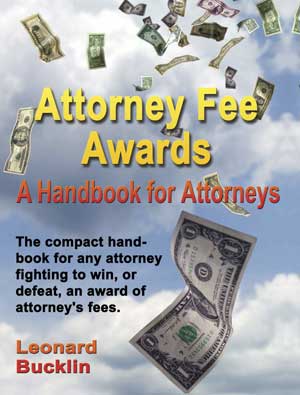
Attorney Fee Awards:
Common fund cases sometimes use percentage as fee award.
There is a class of cases in which the lodestar and its associated twelve-point (federal) or state eight-point (state) criterion lists sometimes are not used as a primary basis for defining/computing a "reasonable fee." Those cases are ones in which a "common fund" has been awarded to benefit an entire class of persons, even though only a few "class representatives" and their attorney actually prosecuted the case.
Instead of having the few plaintiff "class representatives" entirely responsible for paying the winning attorney, it has seemed fair to have each one of the entire class of persons sharing in the common fund also bear their proportionate share of the attorney fee and costs that created the common fund. Courts have therefore sometimes used the class representatives "contingent percentage fee" amount and taken that amount out as the reasonable attorney fee before the common fund is divided among the persons comprising the entire class.
In determining the reasonable attorney fee the court will take out of the common fund, so that all who benefit from the fund bear their share of the cost of obtaining the fund, the courts have sometimes resorted to taking a percentage of the fund out of the fund to be the "reasonable attorney fee." The court thus escapes the task that the tedious accounting that the lodestar method and the twelve or eight-criteria list would entail.
Note: unlike the federal courts and many state courts, some state courts absolutely mandate the lodestar and eight point criteria method in all cases, as the only method the trial court can use in any case to calculate a "reasonable fee".
The object, even using a "percentage of the fund" is still to determine a reasonable attorney fee (hence the contingent fee agreement percentage the attorney may have is not a measure, only something to be considered). Thus, to be sure the percentage is roughly fair as a "reasonable fee," these courts then frequently do a cross-check with a rough lodestar computation to ensure that the hourly rate given the attorneys as a fee is not so much as would shock the conscience or, upon appeal, to be reversed.
The awarding of the attorney fee from the common fund depletes the amount available for distribution among the class of persons benefitted by the successful lawsuit. Thus an unreasonable amount as an attorney fee directly effects the beneficiaries of the fund. Unfortunately, the beneficiaries of the common fund rarely object to the attorney fee request, no matter how outrageous. They have no real incentive to hire their own lawyers to engage in an expensive contest that at best would result in only a tiny pro rata gain to them personally from a fee reduction. On the other side of the table, once the total common fund (including attorney fees) has been agreed upon by the defendants, the defendants have no financial incentive to spend more money to oppose whatever fee award the successful attorneys request from the common fund. That creates a temptation for the defense to offer, and the plaintiffs' lawyers to agree upon, a less-than-optimal settlement for the plaintiffs in exchange for a nominally negotiated large attorney fee to go into the common fund to be distributed as the attorneys' fee.
Only the court stands in the way of the plaintiffs' attorneys gathering an unconscionable windfall in fees. The judges are mindful of their responsibility. I have included in his handbook's Appendices: In re Bristol-Myers Squibb, 2005 WL 447189 (S.D.N.Y.,2005), an excellent case discussing the awarding of common fund attorney fees. It can be read with profit by any attorney seeking to convince the court to award a percentage of the recovery. The case highlights the sort of reasoning that will, or will not, be successful in prosecuting the petition for attorney fees so based.
Goldberger v. Integrated Resources, Inc., 209 F.3d 43(2d Cir.2000) is a federal case giving its sanction to both the lodestar and also the percentage methods for calculating reasonable attorneys' fees in class actions. It is representative of court decisions in the early part of the 21st century . These cases, in determining what percentage to award, typically consider: (1) the risks of pursuing a case; (2) the complexity and uniqueness of the litigation; (3) the quality of representation; (4) counsel's time and effort; (5) the requested fee in relation to the settlement; and (6) public policy considerations
However, since about 2010, trial courts have tended to retreat from the subjective "guess" method involved in picking a percentage to be the fee. Much more common, particularly in the federal courts is the use of the lodestar and its associated criterion list as the primary method of determining the attorney fee.
